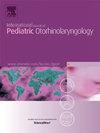An innovative CRISPR/Cas9 mouse model of human isolated microtia indicates the potential contribution of CNVs near HMX1 gene
IF 1.2
4区 医学
Q3 OTORHINOLARYNGOLOGY
International journal of pediatric otorhinolaryngology
Pub Date : 2024-12-01
DOI:10.1016/j.ijporl.2024.112141
引用次数: 0
Abstract
Background
Microtia is a prevalent congenital malformation, the precise etiology and pathogenesis of which remain elusive. Mutations in the non-coding region of the HMX1 gene have been implicated in isolated cases of microtia, emerging as a significant focus of contemporary research. Several pathogenic copy number variations (CNVs) proximal to the HMX1 gene have been documented in wild animal populations, whereas only a single large segmental duplication in this region has been identified in humans. However, the absence of a gene-edited animal model has impeded the investigation of the unclear gene function associated with HMX1 mutations in human isolated microtia. In this study, we sought to precisely identify the pathogenic mutation by analyzing three pedigrees alongside population controls. Subsequently, our objective was to develop a CRISPR/Cas9 gene-edited mouse model to elucidate the functional implications of the identified mutation.
Methods
Genomic DNA was collected from 32 affected individuals across three pedigrees, as well as from 2000 control subjects. Comprehensive genomic analyses, including genome-wide linkage analysis, targeted capture, second-generation sequencing, and copy number analysis, were conducted to identify potential mutations associated with congenital auricle malformation. CRISPR/Cas9 gene-edited murine models were generated in response to the identified mutation. The auricular phenotypes of these gene-edited mice were systematically monitored. Small-animal Micro-CT scanning was employed to identify potential craniofacial or skeletal abnormalities. Furthermore, the expression of the HMX1 gene in the PA2 region of mouse embryos was quantified using RT-qPCR.
Results
A co-segregated 600 base pair duplication located on chromosome 4 (chr4:8701900-8702500, hg19) was identified in affected individuals across three pedigrees, but was absent in healthy controls. Two types of CRISPR/Cas9 gene-edited mice were subsequently generated. The knock-in (KI) mouse model was engineered by inserting one copy of the duplicated sequence directly adjacent to the mutated site, whereas the knockout (KO) mouse model was created by excising the mutation sequence. The phenotypes of different group of CRISPR/Cas9 gene-edited mice demonstrated distinct auricular deformities. Furthermore, an increase in the copy number of the mutated sequence was associated with elevated expression levels of HMX1 in the gene-edited mouse model.
Conclusions
In this study, we further narrowed down and identified a 600 base pair copy number variation (CNV) located at chr4:8701900-8702500 (hg19), which is implicated in human bilateral, isolated microtia. Utilizing CRISPR/Cas9 technology, we developed novel mouse models harboring the identified mutation. These models serve as a robust platform for the comprehensive investigation of the underlying mechanisms of the disease.
一种创新的人类分离小体的CRISPR/Cas9小鼠模型表明了靠近HMX1基因的CNVs的潜在贡献
背景:小体畸形是一种常见的先天性畸形,其确切的病因和发病机制尚不清楚。在HMX1基因的非编码区突变已涉及孤立病例的小个子,成为当代研究的一个重要焦点。在野生动物种群中已经发现了几种接近HMX1基因的致病性拷贝数变异(CNVs),而在人类中只发现了该区域的单个大片段重复。然而,缺乏基因编辑的动物模型阻碍了对人类分离的小体中与HMX1突变相关的不明确基因功能的研究。在这项研究中,我们试图通过分析三个家系以及人口控制来精确识别致病突变。随后,我们的目标是开发CRISPR/Cas9基因编辑的小鼠模型,以阐明鉴定突变的功能含义。方法收集3个家系32例患者的基因组DNA,以及2000例对照。全面的基因组分析,包括全基因组连锁分析、靶向捕获、第二代测序和拷贝数分析,以确定与先天性耳廓畸形相关的潜在突变。根据鉴定的突变,生成了CRISPR/Cas9基因编辑的小鼠模型。系统地监测了这些基因编辑小鼠的耳廓表型。小动物Micro-CT扫描用于识别潜在的颅面或骨骼异常。此外,采用RT-qPCR方法定量小鼠胚胎PA2区HMX1基因的表达。结果在3个家系中发现了位于4号染色体(chr4:8701900-8702500, hg19)上共分离的600个碱基对重复,但在健康对照中不存在。随后产生了两种类型的CRISPR/Cas9基因编辑小鼠。敲入(KI)小鼠模型是通过将复制序列的一个拷贝直接插入到突变位点附近来设计的,而敲除(KO)小鼠模型是通过切除突变序列来创建的。不同组CRISPR/Cas9基因编辑小鼠的表型表现出不同的耳廓畸形。此外,在基因编辑小鼠模型中,突变序列拷贝数的增加与HMX1表达水平的升高有关。结论本研究进一步缩小并鉴定出位于chr4:8701900-8702500 (hg19)的600个碱基对拷贝数变异(CNV),该变异与人类双侧分离的小脑有关。利用CRISPR/Cas9技术,我们开发了含有鉴定突变的新型小鼠模型。这些模型为全面研究该疾病的潜在机制提供了一个强大的平台。
本文章由计算机程序翻译,如有差异,请以英文原文为准。
求助全文
约1分钟内获得全文
求助全文
来源期刊
CiteScore
3.20
自引率
6.70%
发文量
276
审稿时长
62 days
期刊介绍:
The purpose of the International Journal of Pediatric Otorhinolaryngology is to concentrate and disseminate information concerning prevention, cure and care of otorhinolaryngological disorders in infants and children due to developmental, degenerative, infectious, neoplastic, traumatic, social, psychiatric and economic causes. The Journal provides a medium for clinical and basic contributions in all of the areas of pediatric otorhinolaryngology. This includes medical and surgical otology, bronchoesophagology, laryngology, rhinology, diseases of the head and neck, and disorders of communication, including voice, speech and language disorders.

 求助内容:
求助内容: 应助结果提醒方式:
应助结果提醒方式:


